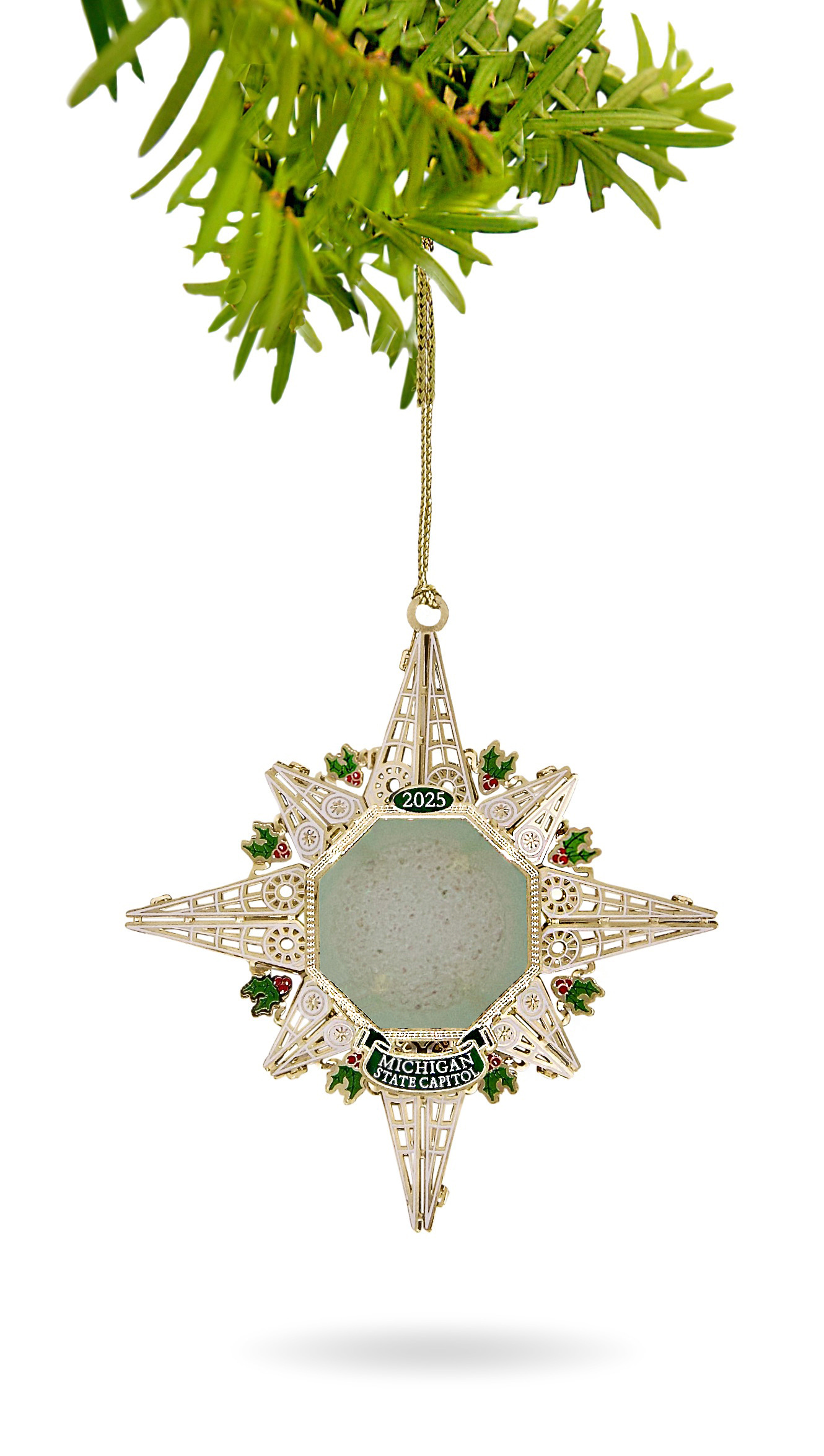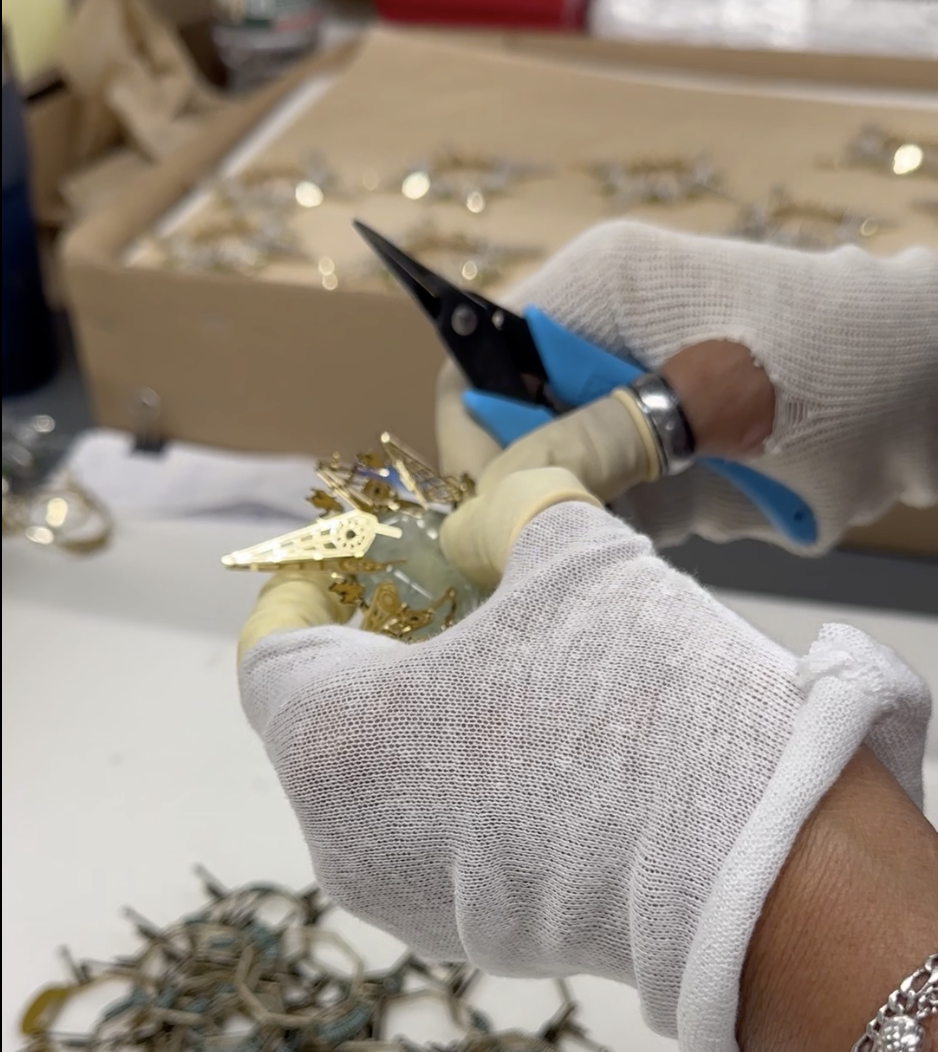
2025 Glass Floor Restoration
The rotunda is considered a level one historic preservation zone, meaning it is an area that is highly visible, has been restored to a high level of authenticity, and contains original materials and decoration. Present-day preservation of this space began with the 2023-2024 restoration of the decorative paint in the dome and rotunda and will continue with the restoration of the glass floor to its intended appearance.

Glass Floor History

Production & Process

Other Glass Floors

Glass Ornament


Our Glass Floor
In the summer of 1878, workers began installing 976 pieces of glass into the new Capitol’s iron rotunda floor frame. According to newspaper reports, approximately 50 tiles could be installed in a day. Tradition says that these glass tiles—sometimes called illuminated tiles—were produced in Lancashire, England, by the London and Manchester Plate Glass Company.

The British Cast Plate Glass Company's plant in Ravenhead.

An illustration showing the casting of glass at the British Cast Plate Glass Company in Ravenhead.

The casting hall of the Ravenhead glass works in Lancashire, England.

Illustration showing the various methods of 19th century glass making in Lancashire, England.

1931-1932 Replacement
On January 18, 1931, a fire broke out in the east wing of the ground floor. Determined as “spontaneous combustion” at a cigar stand, the fire spread to the area underneath the glass floor. Hundreds of tiles cracked from the heat of the blaze, and smoke sifted up through the gaps and into the rotunda. The broken tiles were replaced with glass that was slightly thinner than the original – about 5/8”. As a result, wooden shims were inserted between the glass and the iron frame. The other significant replacement effort occurred during the Capitol’s 1987-1992 restoration.

The 1931 fire led to the replacement of a majority of the glass floor tiles.

Survey work in 2024 uncovered a label underneath a previously thought “original” tile reading “Pressed Prism Plate Glass Co. Morgantown, W. VA.”

Factory of The Pressed Prism Plate Glass Company near Morgantown, West Virginia.

It was discovered during the 2024 survey that the 1930s tiles were thinner than the original English tiles by 3/8”, so wood shims had been added to raise them to the correct level.

1990-1991 Restoration
During the first half of 1991, 46 of the glass floor tiles were replaced. The tiles that needed replacement were first traced on paper.Then a plywood board was cut to scale. The boards were then sent to the College of Creative Studies at the University of Michigan, where a team led by Albert Young cast new plate-glass tiles to match the majority of the existing tiles.We now know, though, that the majority of the tiles at that time were not original, but from the 1930s replacement.

This architectural plan crafted by Wigen, Tincknell, Meyer & Associates in 1990 details the 46 tiles to be replaced.

1991 photo of the glass studio at the College of Creative Arts where the glass floor tiles were produced.

The Christman Company managed the project to replace the glass floor tiles and repair the iron framework.

Tiles set to be replaced were traced on paper. This tracing was used to cut a plywood board to scale.


2025 Glass Floor Project Overview
This undertaking began with a thorough survey of the tiles, led by Executive Director Rob Blackshaw, to identify which ones are original, which were replaced in the 1930s, and which were replaced during the 1987-1992 restoration. The diagram denotes the findings of the survey and identifies the tiles that will be replaced in the current project. With the replacement of all tiles that date to 1931 and 1991, 685 tiles in total will be replaced during the project.
* You'll notice the majority of the remaining original tiles are toward the west end. The 1931 fire occurred at the east end.

Glass Supplier & Production Process
A key factor in making this project possible was finding the right contractors for the job - a team that could not only recreate the glass tiles to match the originals, but that would also understand the importance of the project. After seeing the mock-ups of their glass tiles, Capitol staff chose Lucid Glass Studio of Providence, RI, for the job. Once the tiles have been created, Lansing Glass Company will install them in the rotunda.

The Lucid Glass team of East Providence, Rhode Island.

Lucid Glass Studio of East Providence, Rhode Island.

Lucid glazier gathering sample for color testing.

Pouring molten glass, or hot glass, into a casting mold.

The cooling glass pour with the casting mold removed.

Controlling the cooling of the tile using applied heat.

Antique and distressed colored glass samples.

Lucid Glass sample tile comparison with original tile from the Michigan State Capitol glass floor.


Other Glass Floors
Glass tile floors were not uncommon in the post-Civil War period. Architect E.E. Myers called for glass floors in several of his large buildings, including the State Capitol in Austin, Texas and Old City Hall in Richmond, Virginia. In a pre-electric era, glass floor tiles, laylights, door lights, transom windows, and interior windows amplified the distribution of both natural and man-made lighting.

The rotunda of Old City Hall in Richmond, Virginia features an illuminated glass floor. This is perhaps because the building was designed by Michigan’s architect, Elijah E. Myers.

The G.A.R. Rotunda at the Chicago Cultural Center features a set of 9 glass floor sections underneath a stunning dome. Lucid Glass of Rhode Island restored these glass panels.

2025 Glass Ornament
For years, the historic glass floor bore the weight of history—of lobbyists, legislators, tourists, and governors. But in 2025, it was time for a meticulous restoration.
This preservation project began with the delicate work of Lucid Glass Studio from Providence, Rhode Island. Their mission was one of renewal: to replace the damaged or non-original tiles that had seen a century of Michigan life. Each tile was retrieved with care, a tiny fragment of the state’s heritage temporarily detached from the whole.
It was in this act of removal that a new idea took shape: the displaced glass, too precious to discard, would be repurposed. The responsibility for this transformation fell to Beacon Design, a fellow Rhode Island-based company, and the long-time crafter of the Capitol’s annual Christmas ornaments.

The resulting ornament is more than just a decoration; it is a physical link to the past. It ensures that the glass, which once supported the view up into the dome, will now hang on branches across the state, defining the memory of a visit to the heart of the Michigan State Capitol.
Once cooled and perfected, the custom glass pieces were transferred to Beacon Design. There, designers worked to create the ornate, three-dimensional brass ornament—a concept based on the Capitol’s design vision that mirrored the floor’s iron framework. The design was printed onto brass sheets, meticulously cut out, and shaped using a high-pressure press. The final step was precision handwork: the reclaimed piece of Capitol glass was carefully enclosed within the brass framework by hand, completing the 2025 limited-edition ornament.
The journey was one of intricate renewal, requiring the specialized skills of both studios. Lucid Glass Studio first took the salvaged tiles and used a high-precision water jet to cut the glass into the necessary shapes for the ornament. These pieces were then placed in a kiln cast, a heating process that smoothed the sharp edges and subtly shaped the historic fragments.
The resulting ornament is more than just a decoration; it is a physical link to the past. It ensures that the glass, which once supported the view up into the dome, will now hang on branches across the state, defining the memory of a visit to the heart of the Michigan State Capitol.

